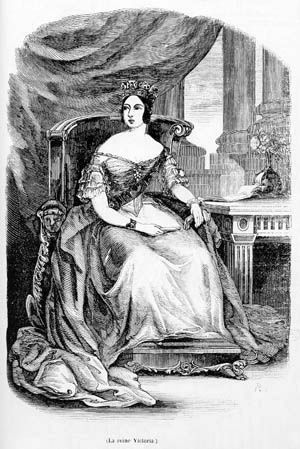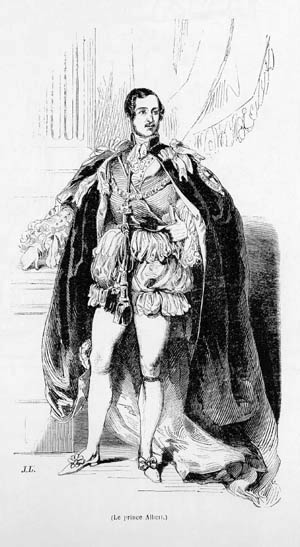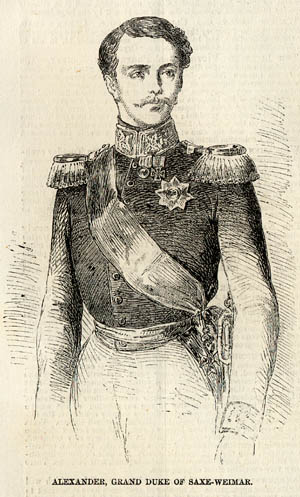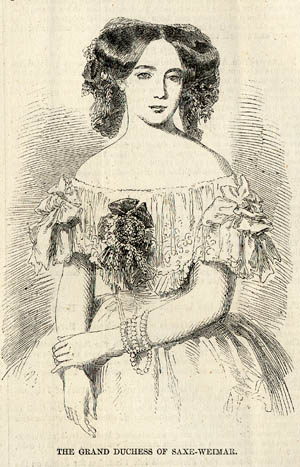Unless otherwise stated all pictures on Berlioz Photos pages have been scanned from engravings, paintings, postcards and other publications in our collection. All rights of reproduction reserved.
This page contains portraits of members of the courts of Great Britain (Queen Victoria and Prince Albert) and of Weimar (the Grand-Duke and Grand-Duchess of Saxe-Weimar).
![]()
Long before he went to London it seems that Berlioz was thinking of trying to gain support from the British monarchy. When publishing his Requiem in 1838 he sent a letter to Queen Victoria asking her to place a subscription for the work: ‘The high protection afforded by the Queen of England to the arts and to music in particular encourages me to beg your Majesty to honour me with her subscription’ (CG no. 544, 17 March 1838). As far as is known the Queen did not reply. But Berlioz continued to pay attention to the London scene and the attitude of the monarchy to music. In 1840 he noted the existence of concerts at the royal court in London where even the Queen and Prince Albert were prepared to sing (Débats 21 June 1840). In 1844 he noted with satisfaction that Prince Albert was openly declaring his support for the instrument-maker Adolphe Sax in London (Débats 23 November and 29 December 1844). Together with other royal families, Queen Victoria and Prince Albert did attend the celebrations in Bonn in August 1845 for the inauguration of the statue of Beethoven (Débats 22 August 1845, reproduced in Soirées de l’orchestre). Berlioz had high hopes for his first visit to London in 1847, but as is well known these were nullified, first by the bankruptcy of the impresario Jullien who had invited him, then by the revolutions of 1848. Queen Victoria and Prince Albert did attend a performance at Drury Lane conducted by Berlioz (16 February 1848), and shortly after (17 or 18 February) part at least of the Symphonie funèbre et tiomphale was performed at Buckingham palace (CG no. 1173), though Berlioz almost certainly did not attend (there is no further mention of the event in his correspondence). When he next returned to London in 1851 on the occasion of the Great Exhibition which had been organised by Prince Albert, Berlioz approached the Prince offering to dedicate to him the (as yet unpublished) Te Deum, which the Prince accepted (CG no. 1418, 11 June 1851. cf. Le Ménestrel 7 October 1894). But the Te Deum was never performed in London in Berlioz’s lifetime. Queen Victoria and Prince Albert did attend, together with other royals, the disastrous performance of Benvento Cellini at Covent Garden on 25 June 1853, but Berlioz immediately withdrew the work. When the Te Deum was eventually published in 1855 and offered for subscription, other royals accepted but Berlioz ‘had no hopes from Prince Albert, to whom this work is dedicated’ (CG no. 2211). From Berlioz’s point of view the British monarchy could not be compared with its German counterparts.


The two above images have been scanned from an 1843 issue of L’Illustration in our collection.
‘Weimar is a city of artists and the ducal family knows how to honour the arts’ wrote Berlioz after his first visit to the city (Débats 28 August 1843, reproduced later in the Memoirs). From Berlioz’s perspective the ducal family of Weimar was at the polar opposite of the British monarchy, and its dedication to the arts persisted as a tradition over generations. It started with the Grand-Duke Carl August (1757-1828), was then pursued by his son and successor Carl Friedrich (1783-1853) and his wife Maria Pavlovna (1786-1859), sister of the Tsar of Russia, and continued by their son Carl Alexander (1818-1901) and his wife Wilhelmine Marie Sophie Louise (1824-1897), daughter of the King of the Netherlands. Berlioz’s first visit to Weimar in 1843, though successful, did not give an indication of how his relations with the city and the ducal family would develop subsequently, and he did not actually meet them on that occasion. But when Liszt settled in Weimar in 1847 together with Princess Sayn-Wittgenstein a new period started, and Berlioz was openly invited to the city and welcomed there by the ducal family. His opera Benvenuto Cellini was revived by Liszt in March-April and November 1852, and again in February-March 1856, all with the active support of the Dowager Grand-Duchess to whom the work was dedicated (CG nos. 1464, 2013, 2191). Berlioz himself was invited on several occasions to give concerts and was warmly received (November 1852, February 1855 and February-March 1856). Liszt eventually left Weimar at the end of 1858, but Berlioz’s relations with the ducal family continued for years to come. In April 1863 his opera Béatrice and Bénédict was staged there with the support of the young Grand-Duchess (Memoirs, Postface), and the Grand-Duke Carl Alexander showed strong interest and support for the opera Les Troyens (see for example CG nos. 2798, 2805, 2857). The relations of Berlioz with Weimar over a period of more than twenty years are traced in detail in the page devoted to that city, which includes a detailed discussion of his relations with successive members of the ducal family.


The two above images have been scanned from an 1857 issue of the Illustrated London News in our collection.
![]()
© (unless otherwise stated) Monir Tayeb and Michel Austin for all the texts and images on Berlioz Photo Album pages.
All rights of reproduction reserved.